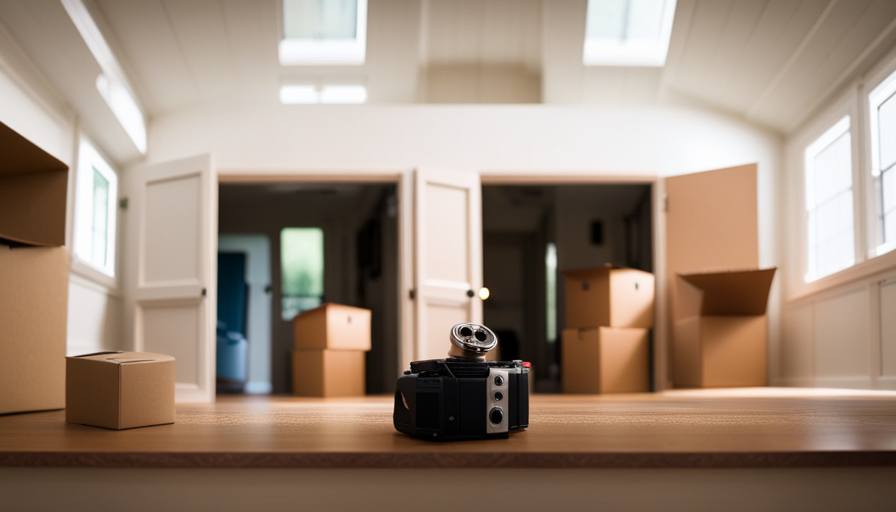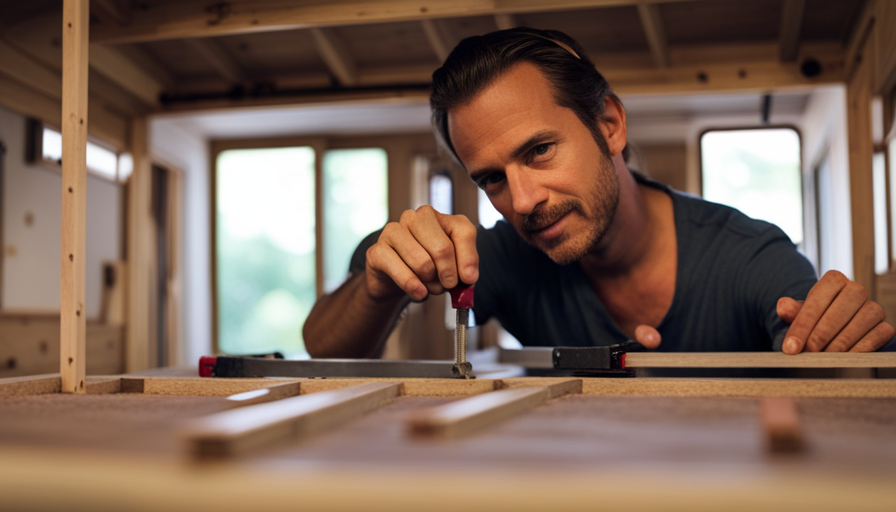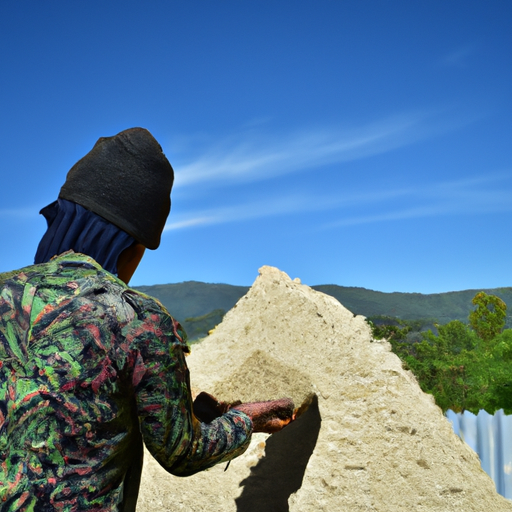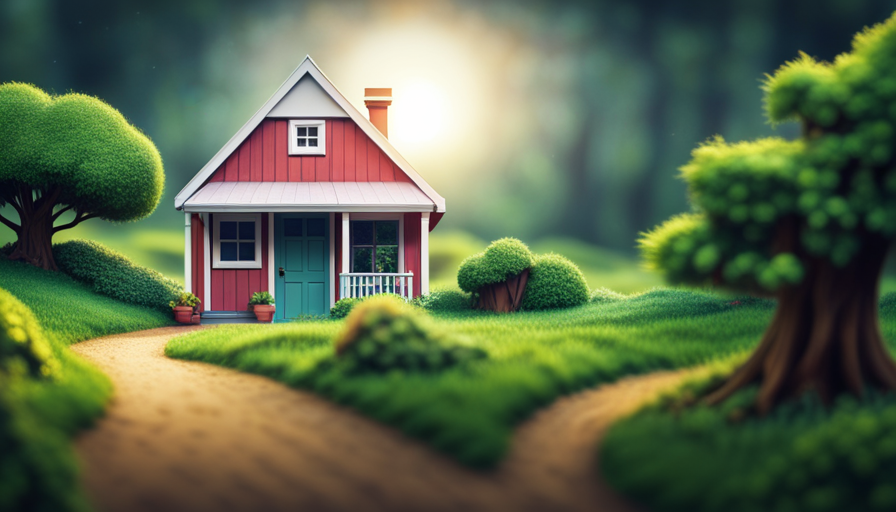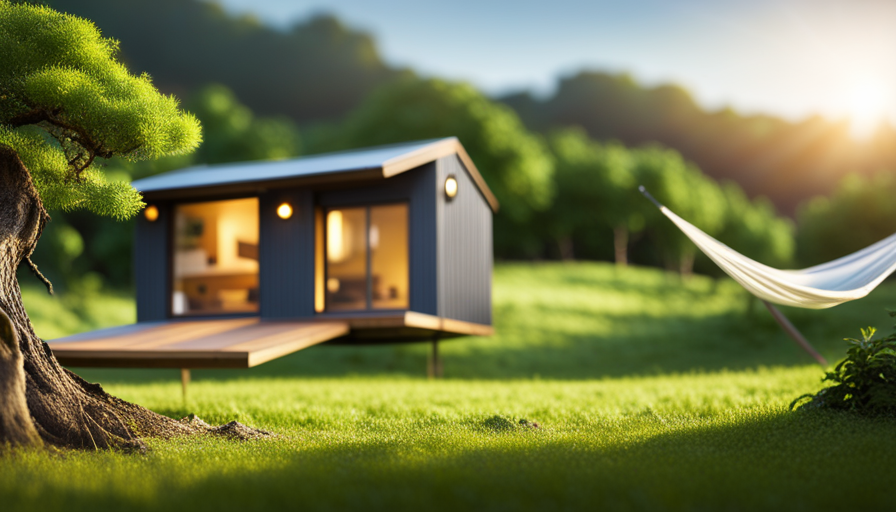Envision a lifestyle characterized by liberty, straightforwardness, and a profound link with what’s genuinely important. Picture yourself living amid nature, free from the weight of too many possessions, in a dwelling that seamlessly suits your requirements. Enter the realm of tiny houses.
Moving into a tiny house is not just a change of address, but a change of mindset. It’s a decision to embrace a minimalist lifestyle and prioritize experiences over material possessions. But don’t be fooled by its size; the process of moving into a tiny house requires careful planning and organization.
In this article, I will guide you through the detailed steps of moving into a tiny house. From finding the perfect location to designing and building your tiny home, downsizing your belongings to managing utilities, and adjusting to the challenges of tiny living.
Get ready to embark on a journey of simplicity, sustainability, and freedom as we explore the intricacies of moving into a tiny house. Let’s dive in and make your tiny house dream a reality.
Key Takeaways
- Finding the perfect location and considering affordability and zoning regulations is crucial when moving into a tiny house.
- Designing a floor plan that maximizes space, strategically placing windows, and incorporating outdoor living spaces can make a tiny house feel more spacious.
- Downsizing and decluttering belongings before moving into a tiny house is important.
- Managing utilities and exploring alternative energy sources for off-grid living is essential.
Finding the Perfect Location for Your Tiny House
Now that you’ve decided to embrace the tiny house lifestyle, it’s time to start searching for that picturesque location where your cozy home will be nestled among towering trees and rolling hills.
Finding affordable land is crucial when it comes to moving into a tiny house. Look for areas with a lower cost of living and explore options like rural areas or small towns where land prices may be more budget-friendly.
Additionally, it’s important to consider zoning regulations. Some areas have specific rules and restrictions regarding tiny houses, so make sure to do your research and find a location where you can legally park and live in your tiny house.
Once you’ve found the perfect location and ensured it meets zoning requirements, you can move on to designing and building your tiny house, creating a space that perfectly fits your needs and desires.
Designing and Building Your Tiny House
When it comes to designing and building my own tiny house, I know that creating a floor plan that maximizes space is crucial. I want to make every inch count and ensure that I have all the necessary amenities without feeling cramped.
Additionally, I’ll carefully choose materials and features that suit my lifestyle, considering factors such as durability, sustainability, and functionality.
Lastly, I’ll weigh the options of hiring professionals or going the DIY route, taking into account my own skills, time availability, and budget constraints.
Create a Floor Plan that Maximizes Space
To truly maximize space in a tiny house, it’s crucial to create a floor plan that utilizes every inch efficiently. When designing your floor plan, consider the layout that will allow for the most natural light to flow into the space.
Strategically placing windows and skylights can help brighten up your tiny house and make it feel more spacious. Additionally, consider incorporating outdoor living spaces, such as a small deck or patio, to extend your living area and create a seamless transition between inside and outside. This not only adds more usable space, but also gives the illusion of a larger home.
Now, let’s move on to the next step and choose materials and features that suit your lifestyle.
Choose Materials and Features that Suit Your Lifestyle
Don’t forget to select materials and features that perfectly match your lifestyle and make your tiny house feel like a cozy home. When choosing materials, opt for sustainable options that are eco-friendly and durable. Consider using reclaimed wood for your flooring and countertops, or bamboo for your cabinetry. Not only will these materials add character to your tiny house, but they’ll also minimize your environmental impact.
Incorporating smart home technology is another great way to make your tiny house functional and convenient. Install a smart thermostat to efficiently regulate the temperature, or use smart lighting that can be controlled remotely. These features won’t only save you energy and money but they’ll also make your life easier.
As you consider hiring professionals or going the DIY route, keep in mind that both options have their benefits. Hiring professionals ensures a high-quality finish and saves you time and effort. On the other hand, going the DIY route allows for customization and cost savings. Consider your skills, budget, and timeline when making this decision.
Consider Hiring Professionals or Going the DIY Route
Consider contracting capable craftsmen or crafting creatively on your own to create a captivating custom creation. Whether you decide to hire professionals or take the DIY route, there are several benefits to both options.
-
Expertise: Hiring professionals ensures that the job will be done with precision and skill. They have the knowledge and experience to handle any challenges that may arise during the construction process.
-
Cost: Going the DIY route can save you money on labor costs, as you won’t have to pay for professional services. However, it’s important to consider your own capabilities and whether you have the necessary skills to complete the project.
-
Personal Touch: By taking on the project yourself, you have the opportunity to add your own personal touch and make the tiny house truly unique to your taste and lifestyle.
Transitioning into the next section, downsizing and decluttering your belongings, is an important step towards creating a functional and organized living space.
Downsizing and Decluttering Your Belongings
Minimizing your possessions is the key to successfully transitioning into a tiny house. Downsizing tips and decluttering strategies are essential in creating a functional and organized living space. Start by assessing your belongings and categorizing them into three groups: keep, donate/sell, and toss. To help you make decisions, use the emotional response table below:
| Keep | Donate/Sell | Toss |
|---|---|---|
| Sentimental items | Unused clothes | Broken or damaged items |
| Essential tools | Duplicate kitchenware | Outdated electronics |
| Everyday essentials | Furniture that doesn’t fit | Expired products |
Be ruthless in your choices, keeping only what truly adds value to your life. Consider the size and functionality of your new space when deciding what to keep. Once you’ve downsized, it’s time to declutter. Organize your belongings using storage solutions like bins, shelves, and hooks to maximize space. Transitioning to managing utilities and off-grid living requires careful planning and innovative solutions.
Managing Utilities and Off-Grid Living
To fully embrace off-grid living in your tiny house, you’ll need to become a master of managing utilities, like a conductor orchestrating a symphony of energy sources.
One of the key aspects to consider is managing your water supply. Since you won’t have access to a traditional water system, you’ll need to find alternative ways to obtain and conserve water. This can include collecting rainwater, installing a filtration system, or even hauling water from a nearby source.
Additionally, you’ll need to explore alternative energy sources to power your tiny house. Solar panels, wind turbines, and propane generators are popular options for generating electricity. It’s important to carefully calculate your energy needs and invest in the right equipment to ensure a reliable power supply.
Now that you have a grasp on managing utilities, let’s dive into maximizing storage and organization in a tiny space.
Maximizing Storage and Organization in a Tiny Space
When it comes to maximizing storage and organization in a tiny space, I’ve found that utilizing multi-functional furniture and storage solutions is key. By investing in pieces that serve multiple purposes, such as a bed with built-in storage or a table that can be folded down when not in use, I’m able to make the most of every inch of my tiny home.
Additionally, optimizing vertical space with shelving and hooks has been a game changer for me. I can hang pots and pans on hooks in the kitchen, use floating shelves to display and store items, and even install a wall-mounted shoe rack to save on floor space.
Lastly, developing efficient systems for daily living has helped me stay organized and make the most of my tiny space. From creating designated storage areas for specific items to implementing routines for cleaning and decluttering, having a plan in place has made a world of difference.
Utilize Multi-Functional Furniture and Storage Solutions
Make sure you take advantage of multi-functional furniture and storage solutions to maximize your space in a tiny house. When every square inch counts, it’s crucial to choose furniture that serves multiple purposes. Look for pieces that can transform, such as a sofa that converts into a bed or a dining table that doubles as a desk.
Additionally, opt for storage solutions that are designed to make the most of your limited space. Consider using ottomans with hidden compartments, wall-mounted shelves with built-in drawers, or under-bed storage containers. These multi-functional furniture pieces and storage solutions will help you keep your belongings organized and easily accessible while minimizing clutter. By utilizing these space-saving strategies, you can create a functional and comfortable living environment in your tiny house.
Now, let’s explore how to optimize vertical space with shelving and hooks.
Optimize Vertical Space with Shelving and Hooks
Maximize your vertical space with the use of shelves and hooks, creating a visually stunning and organized tiny home. Here are four ways to optimize your vertical space:
-
Vertical Gardening: Utilize wall-mounted planters and hanging baskets to bring nature indoors. Not only does this add a touch of greenery to your space, but it also maximizes your vertical space by utilizing the walls for growing herbs, flowers, and even vegetables.
-
Creative Storage Solutions: Install floating shelves or wall-mounted cabinets to store books, kitchen essentials, or decorative items. You can also hang hooks on the walls to hang coats, hats, or bags, keeping them off the floor and creating more floor space.
-
Incorporate Overhead Storage: Install overhead shelves or storage units above doorways or windows to store items like seasonal clothing, luggage, or rarely used items. This frees up valuable floor and closet space.
-
Utilize Corner Shelving: Install corner shelves to make the most of the often-underutilized corner space. Use them to display decorative items, store extra toiletries in the bathroom, or keep kitchen utensils easily accessible.
By implementing these vertical space optimization techniques, you can create a functional and aesthetically pleasing tiny home. Developing efficient systems for daily living will further enhance your living experience in this small but cozy space.
Develop Efficient Systems for Daily Living
Create a seamless and organized daily routine by implementing efficient systems that streamline your day-to-day activities in your cozy living space. Developing a sustainable lifestyle is not only beneficial for the environment but also essential in a tiny house where resources are limited. Incorporating green technology such as solar panels and rainwater harvesting systems can help reduce your ecological footprint. Additionally, establishing efficient systems for tasks like cooking, cleaning, and laundry can save you time and energy. Consider using multi-functional appliances and opting for eco-friendly cleaning products. To give you an idea of how to develop these systems, here is a table that outlines a sample daily routine in a tiny house:
| Task | Time |
|---|---|
| Morning Routine | 7:00 – 8:00 AM |
| Meal Prep | 8:00 – 9:00 AM |
| Work | 9:00 AM – 5:00 PM |
| Chores | 5:00 – 6:00 PM |
| Relaxation | 6:00 – 8:00 PM |
By developing efficient systems, you can embrace a minimalist lifestyle in your tiny house without feeling overwhelmed.
Embracing a Minimalist Lifestyle in Your Tiny House
Embrace the freedom of a minimalist lifestyle in your tiny house, where every square inch becomes a canvas for your dreams to paint. To truly embrace this lifestyle, start by adopting minimalist decor. Keep only the essentials and choose furniture that serves multiple purposes. Opt for a neutral color palette and use natural materials to create a calm and serene environment.
Embracing sustainable living is also key in a tiny house. Install energy-efficient appliances, use natural cleaning products, and implement recycling systems. Living with less not only reduces clutter but also reduces your environmental footprint.
Adjusting to life in a tiny house and overcoming challenges requires a shift in mindset. It’s about finding joy in simplicity and prioritizing experiences over possessions. By living intentionally and embracing the minimalist lifestyle, you’ll discover a world of possibilities in your tiny haven.
Adjusting to Life in a Tiny House and Overcoming Challenges
Get ready to navigate the joys and challenges of adjusting to life in your cozy little haven and find creative solutions along the way!
Adjusting to limited space is a major aspect of living in a tiny house. To make the most of your space, consider investing in multi-functional furniture, such as a sofa that can be transformed into a bed or a dining table that can be folded away when not in use.
Another helpful tip is to maximize vertical space by utilizing wall-mounted shelves or hanging organizers.
Maintaining privacy in a tiny house can be a concern, but there are solutions. Consider using curtains or room dividers to create separate zones within your tiny home. Additionally, strategic placement of furniture can help create a sense of privacy.
Embrace the challenges, get creative, and enjoy the unique experience of living in a tiny house!
Frequently Asked Questions
What are some common challenges that people face when transitioning to a tiny house lifestyle?
Transitioning to a tiny house lifestyle can be challenging and requires adapting to a new way of living. Some common challenges include adjusting to the limited space, downsizing belongings, and managing utilities in a smaller home.
Additionally, finding suitable parking and dealing with zoning regulations can be obstacles. It’s important to plan ahead, declutter, and prioritize your needs to successfully navigate the transition. Being open to change and embracing a simpler lifestyle can help overcome these challenges.
How can I ensure that my tiny house is energy-efficient and sustainable?
To ensure that my tiny house is energy-efficient and sustainable, I’ll focus on incorporating energy-efficient design and using sustainable materials. This includes installing energy-efficient appliances and using LED lighting. I’ll also insulate the walls and roof to minimize heat loss. Additionally, I’ll consider using renewable energy sources, such as solar panels, and incorporating rainwater harvesting systems. Choosing sustainable materials like reclaimed wood and recycled insulation will further reduce the environmental impact of my tiny house.
Are there any specific building codes or regulations that I need to be aware of when constructing a tiny house?
When it comes to constructing a tiny house, it’s important to be aware of the building codes and regulations that may apply. These codes, like a towering mountain range, ensure the safety and integrity of your tiny abode.
From obtaining building permits to adhering to construction regulations, it’s crucial to navigate this terrain with caution. Familiarize yourself with local zoning laws and regulations to ensure a smooth and successful tiny house construction journey.
What are some creative storage solutions for maximizing space in a tiny house?
When it comes to creative storage solutions and space-saving techniques in a tiny house, there are plenty of options to maximize the limited space. Utilizing vertical space with tall shelving units and hanging organizers can free up valuable floor space.
Convertible furniture such as sofa beds and folding tables are also great choices. Additionally, utilizing under-bed storage, wall-mounted hooks, and built-in cabinets can help keep things organized and make the most of every inch in your tiny house.
How do I handle waste management and composting in a tiny house?
Waste management solutions and composting techniques are essential in a tiny house. Let me share some practical tips.
To handle waste, I use a combination of recycling, composting, and minimizing my overall consumption. I separate recyclables from regular trash and make sure to dispose of them properly.
For composting, I use a small compost bin and follow the guidelines for composting organic waste. It’s a simple yet effective way to reduce my environmental footprint.
Conclusion
In conclusion, moving into a tiny house isn’t just about downsizing your physical space, but also about embracing a whole new way of life. It’s about finding freedom in simplicity and discovering the true value of what really matters.
Like a butterfly emerging from its cocoon, living in a tiny house allows us to spread our wings and fly, unburdened by the weight of excess belongings.
So take the leap, embrace the challenge, and let your tiny house become the canvas on which you paint the masterpiece of your minimalist life.
Hi, I’m Emma. I’m the Editor in Chief of Tiny House 43, a blog all about tiny houses. While tree houses are often associated with childhood, they can be the perfect adult retreat. They offer a cozy space to relax and unwind, surrounded by nature. And since they’re typically built on stilts or raised platforms, they offer stunning views that traditional homes simply can’t match. If you’re looking for a unique and romantic getaway, a tree house tiny house might just be the perfect option.
